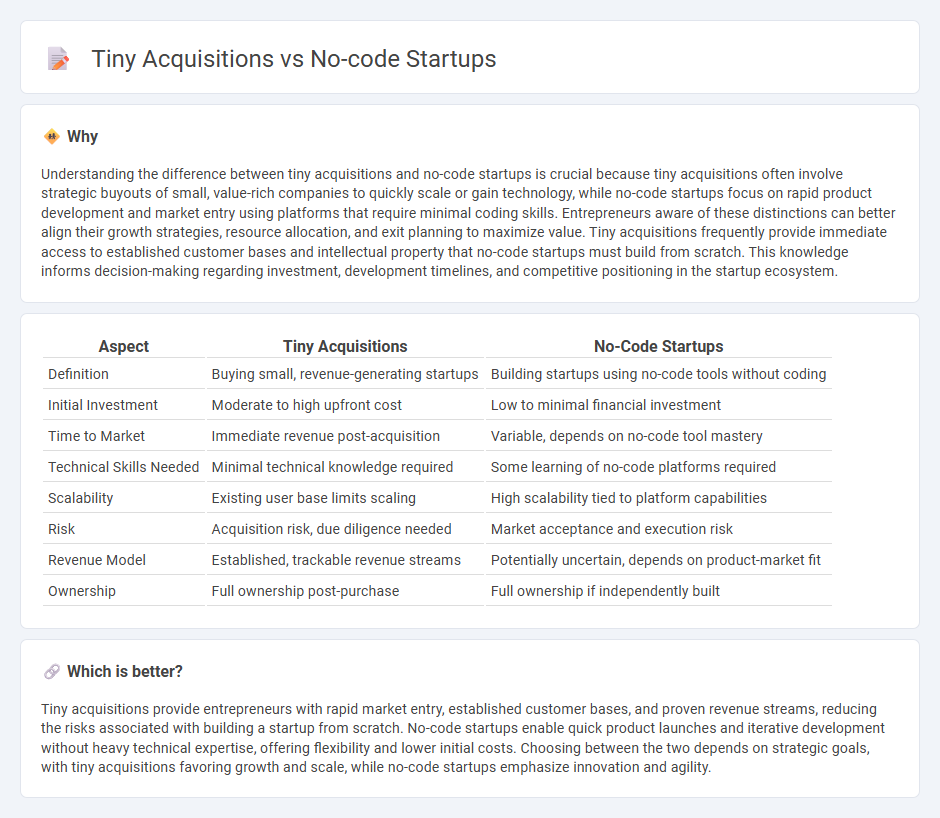
Tiny acquisitions offer entrepreneurs a strategic pathway to quickly scale businesses by purchasing small, profitable companies with established customer bases and revenue streams. No-code startups empower founders to rapidly develop and launch digital products without extensive coding knowledge, significantly reducing time and development costs. Explore how these innovative approaches can transform entrepreneurial success in today's dynamic market.
Why it is important
Understanding the difference between tiny acquisitions and no-code startups is crucial because tiny acquisitions often involve strategic buyouts of small, value-rich companies to quickly scale or gain technology, while no-code startups focus on rapid product development and market entry using platforms that require minimal coding skills. Entrepreneurs aware of these distinctions can better align their growth strategies, resource allocation, and exit planning to maximize value. Tiny acquisitions frequently provide immediate access to established customer bases and intellectual property that no-code startups must build from scratch. This knowledge informs decision-making regarding investment, development timelines, and competitive positioning in the startup ecosystem.
Comparison Table
| Aspect | Tiny Acquisitions | No-Code Startups |
|---|---|---|
| Definition | Buying small, revenue-generating startups | Building startups using no-code tools without coding |
| Initial Investment | Moderate to high upfront cost | Low to minimal financial investment |
| Time to Market | Immediate revenue post-acquisition | Variable, depends on no-code tool mastery |
| Technical Skills Needed | Minimal technical knowledge required | Some learning of no-code platforms required |
| Scalability | Existing user base limits scaling | High scalability tied to platform capabilities |
| Risk | Acquisition risk, due diligence needed | Market acceptance and execution risk |
| Revenue Model | Established, trackable revenue streams | Potentially uncertain, depends on product-market fit |
| Ownership | Full ownership post-purchase | Full ownership if independently built |
Which is better?
Tiny acquisitions provide entrepreneurs with rapid market entry, established customer bases, and proven revenue streams, reducing the risks associated with building a startup from scratch. No-code startups enable quick product launches and iterative development without heavy technical expertise, offering flexibility and lower initial costs. Choosing between the two depends on strategic goals, with tiny acquisitions favoring growth and scale, while no-code startups emphasize innovation and agility.
Connection
Tiny acquisitions often serve as strategic exits for no-code startups, enabling founders to capitalize on agile product development without extensive coding. No-code platforms accelerate innovation by lowering technical barriers, making these startups attractive targets for companies seeking rapid integration of niche functionalities. The synergy between no-code solutions and tiny acquisitions fosters a dynamic ecosystem that fuels scalable growth and efficient market entry.
Key Terms
No-code startups:
No-code startups rapidly innovate by enabling users to build software without traditional programming, reducing development time and costs significantly. These platforms empower non-technical entrepreneurs and businesses to create customized solutions, driving widespread digital transformation across industries. Explore how no-code startups are revolutionizing software creation and reshaping the future of technology.
Visual Development
No-code startups leverage visual development platforms to accelerate software creation, reducing reliance on traditional coding and enabling rapid prototyping and deployment. Tiny acquisitions in this space often target niche no-code tools to integrate specialized features or expand product ecosystems quickly. Explore how these strategies shape innovation and market dynamics in the visual development landscape.
Automation
No-code startups revolutionize automation by enabling users to create workflows and applications without traditional programming, accelerating digital transformation in enterprises. Tiny acquisitions often target specialized automation tools to enhance existing platforms quickly and efficiently, boosting innovation through strategic integration. Explore how no-code solutions and micro-acquisitions drive automation advancements across industries.
Source and External Links
10 Best No-Code Startups and Companies in 2023 - Examples of successful no-code startups include Qoins, a fintech app helping users pay off debt that raised $2.3M; and Makerpad, an e-learning platform acquired by Zapier, both built using tools like Bubble and Webflow.
11 Successful No-Code Startups and Companies - Nomtek - Notable no-code startups include Bloom Institute of Technology, which raised $122M using platforms like Webflow and Airtable, and Dividend Finance, which used Bubble to process over $1 billion in sales and raised $384M.
10 Examples of startups that scaled to millions of dollars with no-code - Comet, a vetted freelancer marketplace, built its MVP with Bubble and secured $12.8M in venture capital, reaching $800K MRR early on; highlighting the potential of no-code in scaling startups.
 dowidth.com
dowidth.com